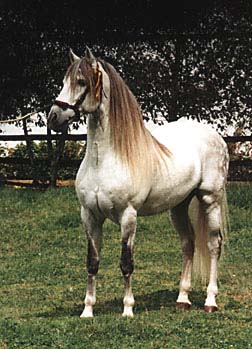
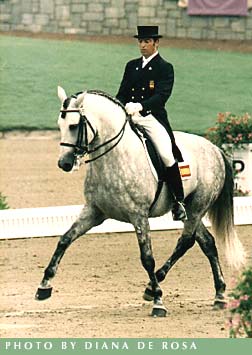
Andalusian


Introduction: This is a magnificent breed of international importance. If you have any comments or suggestions, please click here.
Names: Andalusian, sometimes called Spanish Andalusian. Often referred to simply as the Spanish horse. More recently, I have become somewhat acquainted with the term "Pura Raza Espanol" or PRE, which I originally thought referred to the Andalusian. However, it seems that these are considered two different breeds, so I must do some research to determine what the difference is.
Origin: The prehistoric horses of the Iberian Peninsula had evolved into an exceptional breed that served in the earliest Spanish cavalries and earned extra recognition when they caught the eye of Roman invaders in the third century BC. Roman breeding farms sprang up in the southern kingdom of Andalusia, where most of these horses lived, and Julius Caesar commandeered the best of them for his campaigns.
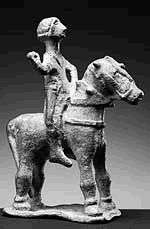
According to Roman mythology, the ancient Iberian horse was partly born of
Cefiro (or Zephyr), the
soft west wind.
According to the most probable accounts, the Moors introduced their African Barbs
to Spain during their invasion in the 700s and crossed them with Iberian horses to produce the Andalusian breed.
Systematic breeding of the Andalusian began in 1571 when Philip II of Spain
founded the royal stables at Cordoba.
According to one source: The Andalusian goes back to
the old Iberian horse of antiquity. Horse breeding, which declined during
the mass migration of the population was given a new impetus under the Moors,
particularly through the introduction of Barbs and Arabs. The heyday of
the Spanish horse was in the sixteenth and seventeenth centuries when it became
the progenitor of practically all European saddle horse strains. Its
direct descendants are, for instance, the Lipizzaner, Kladruber, and
Frederiksborg. But the East Friesian, Oldenburg, Holstein and Orlov
Trotter also go back to the Andalusian.
Breeding: The
Andalusian most probably descends from the Barbs
and Arabs
introduced into Spain during the Moorish invasion of the eighth century A.D.,
which were crossed time and again with native breeds, especially ponies.
According to another theory, however, it is descended from the Equus ibericus,
which conversely, contributed to the development of the Barb,
having crossed the isthmus that then linked Africa with Europe (the present-day
Straits of Gibraltar), thus reaching North Africa. Finally, there are
those who claim that the Andalusian is descended from the two thousand Numidian
mares that were shipped across the Mediterranean to Spain by the Carthaginian
general Hasdrubal (younger brother of Hannibal).
In 1968, a British stallion, Lympne Golden Espanto, of Thoroughbred
and champion Hungarian Shagya
blood, was shipped to Spain as a gift to the celebrated
horseman, Senor Peralta, for use with the Andalusians at his stud near Seville.
Breeding areas: Spain, Andalusia, Province of Cadiz,
Seville, Medina Sidonia. Studs: Moratalla, Jerez de la Frontera,
Cordoba. (These areas and studs being the original home of the Spanish
horse, it is worthwhile to note that they are now bred around the world,
including in increasing number in the United States.)
According to one source, the Andalusian was bred in Spain in
the regions of Cordoba, Seville, and Cadiz, and along the Guadalquivir River.
In earlier times there two types, the light Jennet and the heavier Villanos (the
latter bred mainly in Castile).
Description: In 1774, Andalusian horses were described as having "thick necks with much mane . . . a fiery eye and noble bearing. Horses of much pomp and ceremony." Today they are lighter and speedier, but they retain their distinguished bearing and elegant action. A horse of the mesomorphic type.
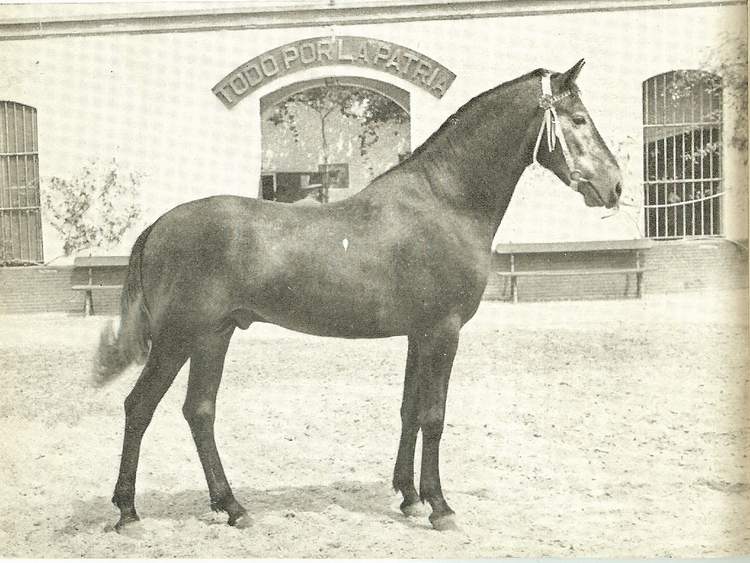
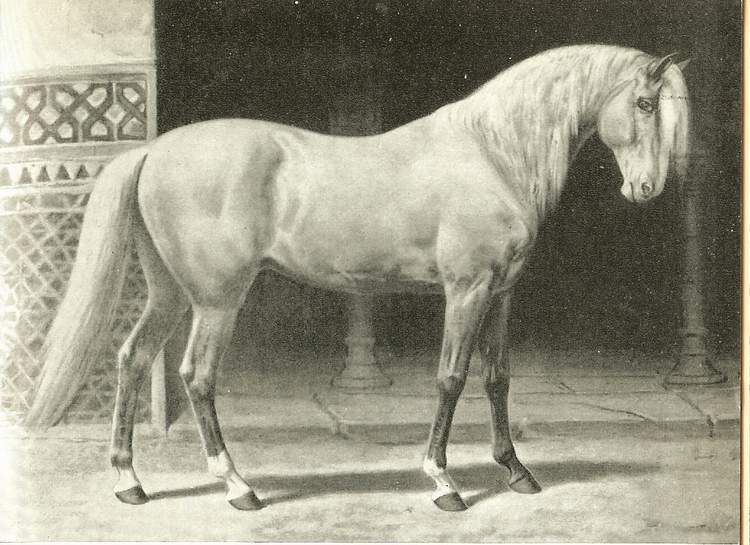
(I couldn't resist including the above two pictures from The Young Specialist Looks At Horses. This source stated that the general impression is a little weak, being of a rather rounded shape, but nevertheless elegant and attractive. Apparently, the author preferred the Thoroughbred type to the Spanish horse, but it may also be based from pictures such as the one on the left, which bear somewhat less of the old warhorse look. The one on the right is an Andalusian of an old strain and more closely resembles the original Spanish horse, to which look pictures like the ones at the top of the page indicate breeders may be returning.)
Action: Rather stately and elegant; high knee action, short stride, not always absolutely regular.
Body: Deep and short, with straight, short back; well-curved ribs; roundish abdomen; and powerful, rounded quarters. Chest broad and deep. Long, thick, arched neck, well-proportioned, curved, and well set-on. Shoulder muscular and nicely sloping. Thick-set rump with good barrel; withers low and round; croup also rounded.
Color: Gray or white usual. Also black, bay, brown, chestnut or roan.
Hair: Mane and tail of long, thick silky hair. Tail low-set, thick and wavy. The same old source as above-mentioned mentioned the tail as sparse, but must have been referencing a poor example of the breed!
Head: Long and handsome, with large and expressive eyes. Ears small and set rather low, with the tips facing outwards. Broad forehead, with profile straight or sometimes convex. An old source said it frequently has a dished nose, but the sketch that went with it showed one with the proper Roman nose that is so common with this breed.
Hooves: Well-formed.
Legs: Strong with broad joints and long pasterns. One old source described the limbs as usually too light in relation to the body, with knees and hocks often defective, particularly the latter; however, I have heard these complaints about the breed nowhere else. Interestingly, the cannons have been described as both long and short; I am inclined to think they are relatively short, but will have to check out more sources.
Size: 15.2-16 hands. Another source says 15.1 to 15.3 hands (1.55 to 1.60 meters), and weighing around 1,250 pounds (570 kilograms).
Temperament: Balanced and energetic. Good, reliable disposition, and fiery temperament.
Features: Very
surefooted. Hard hooves and fine body hair are adaptations for the hot,
dry climate. Not built to gallop, but are supple and agile, courageous and
spirited. The Andalusian was greatly admired in the past for its elegant
gait which included the paso de andatura, a high-stepping movement that
is very effective in parades.
Medium-sized, elegant, pleasant and fairly light saddle
horse.
Uses: Popular riding horse. Good jumper. Sometimes used as a circus horse. Demonstrations of the high-school work done so naturally by the Andalusian horse were popular among European nobility. As a result, Andalusians were used to found many other breeds from the 15th to the 18th centuries. For several centuries, it was the premier riding horse in Europe, and was used in most Renaissance riding schools.
Accomplishments:
It was this spirited breed that
accompanied conquistadors to the New World and returned Equus to its
original home. These Spanish discoverers of the 15th century were the first to
re-introduce horses to the New World since the vast prehistoric herds became
extinct. Without these horses, on which the Spaniards relied for
transport, the growth of discovery and conquest would have been retarded for
centuries.
From the twelfth to the
seventeenth century the Andalusian dominated horse breeding in Spain, its only
rival being the Arab. Either directly, or through the Neapolitan horse,
itself a descendant of the Andalusian, it influenced most European breeds, and
as a result of having been shipped across the ocean by Christopher Columbus on
his second expedition across the Atlantic, has contributed to the development of
almost all American breeds. The most important European breeds to have
been influenced are the Lipizzaner,
the Friesian,
the Hackney,
the Kladruber,
the Frederiksborg,
the Oldenburg,
the Holstein,
the old Norman horse, and the Orlov;
of the American breeds the Quarter
Horse and the Criollo
have been most markedly influenced.
Curiosities: Many of Richard I's knights rode Spanish
destriers.
The quality of Spanish horses was also recognized in Edward II's reign. In
the 17th century, the Duke of Newcastle considered them "the gentlemen and
princes of their kind."
The Duke of Buckingham, who was sent to negotiate an alliance
between Prince Charles (later Charles I) and the Infanta Maria, was bought off
with gifts and shiploads of Spanish horses—most of which reached the Duke's
friends instead of the Royal stalls.
What was it like to see a horse for the first time? Or,
in the 1500s, horses in tandem with bells on their necks and soldiers on their
backs? "Foam from their muzzles drips onto the ground in fat drops
like a lather of soap," wrote one Aztec observer, who wondered if the
animals were giants of the deer family. "When they run, they make a
loud noise, as if stones were raining on the earth." Other Native
Americans speculated that the newcomers were unusually large dogs. And
many rubbed themselves with their sweat to acquire the magic of the awesome
creatures that had just stepped foot on their land.
Profiles:
Conclusion: Interestingly, according to one source, the breed commonly known as the Andalusian should more properly be defined as the "Spanish Horse," as the true Andalusian differs in various features: it is of a heavier build, it does not include gray or chestnut in its range of coats, the height at the withers does not exceed 15.1 hands (1.55 meters), the back is more gathered, the quarters are more developed and the foot is smaller. Although this breed is not now as popular as it once was, it is still of considerable importance because of its distinctive influence on many modern breeds. Today it is mostly used for pleasure riding, and it is only in the bullring or at the corrida that it relives its glorious past.